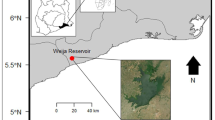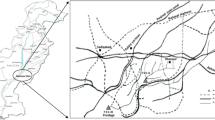Abstract
Fish is consumed as a common food by humans due to its nutritional and therapeutic benefits. However, they can accumulate toxic chemicals (such as heavy metals, persistent organic pollutants) from water and food chain. Very few studies have been investigated on heavy metal contents in fish from Tibetan Autonomous Region of China. In order to study heavy metals levels in fish from aquaculture farms and evaluate the risk that human consume fish in this area, we collected four types of aquaculture fish species (6 big-head carps, 5 grass carps, 5 carps and 5 tilapias) from fisheries around Lhasa city in this study. 9 heavy metals (Cr, As, Cd, Pb, Cu, Ba, Co, Mn and V) in different tissues of fish were determined by an inductively coupled plasma mass spectrometer. Cr, Ba, Co, Mn and V could easily accumulate in the gill, and Cu was detected in the hearts of all the fishes. Toxic metal (As, Cd and Pb) contents were higher in the liver than those in other tissues, heavy metal levels were the lowest in the muscle among all tissues. Most of heavy metal concentrations in the tilapia tissues were higher than those in other fish tissues, especially arsenic. Arsenic content in the tilapia samples was ~2–4 times higher than the maximum levels (MLs) of contaminants in the national standard, and other metals were all lower than the MLs. Compared the estimated daily intake of heavy metals through fish consumption with tolerable daily intakes recommended by FAO, the metals daily intake of As, Cd and Pb from fish consumption might not pose serious health risk to the local inhabitants. It is therefore necessary to determine the dose level for human, which is considered to be taken daily over a lifetime without adverse effects.


Similar content being viewed by others
References
Almeida JA, Diniz YS, Marques SFG, Faine IA, Ribas BO, Burneiko RC, Novelli EIB (2002) The use of oxidative stress responses as biomarkers in Nile Tilapia (Oreochromis niloticus) exposed to in vivo cadmium contamination. Environ Int 27:673–679
Baars A, Theelen R, Janssen P, Hesse J, van Apeldoorn M, Meijerink M, Verdam L, Zeilmaker M (2001) Re-evaluation of human toxicological maximum permissible risk levels. RIVM Rep 711701:025
Castro-Gonzalez IM (2002) Acidos grasos omega-3: beneficios y Fuentes. Interciencia 27:128–136
Clarkson WT (2002) The three modern faces of mercury. Environ Health Perspect 110:11–23
Cooper CB, Doyle ME, Kipp K (1991) Risk of consumption of contaminated sea-food, the Quincy Bay Case Study. Environ Health Perspect 90:133–140
Devlin EW (2006) Acute toxicity, uptake and histopathology of aqueous methyl mercury to fathead minnow embryos. Ecotoxicology 15(1):97–110. doi:10.1007/s10646-005-0051-3
Dominogo JL, Bocio A, Flaco G, Llobet JM (2007) Benefits and risk of fish consumption. Part I. A quantitative analysis of the intake of omega-3 fatty acids and chemical contaminants. Toxicology 230:219–226
Ge KY (1992) The Status of Nutrient and Meal of Chinese in the 1990s. Hygiene Press, Beijing, pp 415–434
Heier LS, Lien IB, Strømseng AE, Ljønes M, Rosseland BO, Tollefsen KE, Salbu B (2009) Speciation of lead, copper, zinc and antimony in water draining a shooting range—time dependant metal accumulation and biomarker responses in brown trout (Salmo trutta L.). Sci Total Environ 407(13):4047–4055
Huang X, Sillanpää M, Gjessing ET, Peräniemi S, Vogt RD (2010) Environmental impact of mining activities on the surface water quality in Tibet: Gyama valley. Sci Total Environ 408(19):4177–4184
Jaric I, Visnjic-Jeftic Z, Cvijanovic G, Gacic Z, Jovanovic Lj, Skoric S, Lenhardt M (2011) Determination of differential heavy metal and trace element accumulation in liver, gills, intestine and muscle of sterlet (Acipenser ruthenus) from the Danube River in Serbia by ICP-OES. Microchem J 98:77–81
Jiang QT, Lee TKM, Chen K, Wong HL, Zheng JS, Giesy JP, Lo KKW, Yamashitad N, Lam PKS (2005) Human health risk assessment of organochlorines associated with fish consumption in a coastal city in China. Environ Pollut 136:155–165
Jones I, Kille P, Sweeney G (2001) Cadmiun delays growth hormone expression during rainbow trout development. J Fish Biol 59:1015–1022
Kris-Etherton PM, Harris WS, Appel LJ (2002) Fish consumption, fish oil. Omega-3 fatty acids, and cardiovascular disease. Circulation 106:2747–2757
Macken A, Giltrap M, Ryall K, Foley B, McGovern E, McHugh B, Davoren M (2009) A test battery approach to the ecotoxicological evaluation of cadmium and copper employing a battery of marine bioassays. Ecotoxicology 18(4):470–480. doi:10.1007/s10646-009-0305-6
Megeer JC, Szebedinszky C, McDonald DG, Wood CM (2000) Effect of chronic sublethal exposure to waterborne Cu, Cd, or Zn in rainbow trout 1: iono-regulatory disturbance and metabolic costs. Aquat Toxicol 50(3):231–243
Ozmen M, Gungordu A, Kucukbay FZ, Guler RE (2006) Monitoring the effects of water pollution on Cyprinus carpio in Karakaya Dam Lake, Turkey. Ecotoxicology 15(2):157–169. doi:10.1007/s10646-005-0045-1
Poleksic V, Lenhardt M, Jaric I, Djordjevic D, Gacic Z, Cvijanovic G, Raskovic B (2010) Liver, gills and skin histopathology and heavy metal content of the Danube Sterlet (Acipenser ruthenus LINNAEUS, 1758). Environ Toxicol Chem 29:515–521
Ramirez-Perez T, Sarma SSS, Nandini S (2004) Effects of mercury on the life table demography of the rotifer Brachionus calyciflorus pallas (rotifera). Ecotoxicology 13(6):535–544. doi:10.1023/b:ectx.0000037190.09248.62
Sawasdee B, Kohler HR (2010) Metal sensitivity of the embryonic development of the ramshorn snail Marisa cornuarietis (Prosobranchia). Ecotoxicology 19(8):1487–1495. doi:10.1007/s10646-010-0534-8
Silva KTU, Pathiratne A (2008) In vitro and in vivo effects of cadmium on cholinesterases in Nile tilapia fingerlings: implications for biomonitoring aquatic pollution. Ecotoxicology 17(8):725–731. doi:10.1007/s10646-008-0221-1
Skoric S, Visnjić-Jeftic Z, Jaric I, Djikanovic V, Mickovic B, Nikcevic M, Lenhardt M (2012) Accumulation of 20 elements in great cormorant (Phalacrocorax carbo) and its main prey, common carp (Cyprinus carpio) and Prussian carp (Carassius gibelio). Ecotoxicol Environ Saf 80:244–251
Türkmen A, Türkmen M, Tepe Y, Akyurt I (2005) Heavy metals in three commercially valuable fish species from Iskenderun Bay, Northern East Mediterranean Sea. Turk Food Chem 91:167–172
UNEP/FAO/WHO (1992) Assessment of dietary intake of chemical contaminants. United Nations Environmental Program, Nairobi
USEPA (1989) Risk assessment guidance for superfund. In: Human Health Evaluation Manual Part A, Interim Final, vol. I. United States Environmental Protection Agency, Washington, DC. 1989 EPA/540/1-89/002
Visnjic-Jeftic Z, Jaric I, Jovanovic Lj, Skoric S, Smederevac-Lalic M, Nikcevic M, Lenhardt M (2010) Heavy metal and trace element accumulation in muscle, liver and gills of the Pontic shad (Alosa immaculata Bennet 1835) from the Danube River (Serbia). Microchem J 95:341–344
WHO, World Health Organization (1993) Evaluation of certain food additives and contaminants (41st report of the joint FAO/WHO expert committee on food additives). WHO Tech. Reports Series No. 837
Xie WP, Chen KC, Zhu XP, Nie XP, Zhen GM, Pan DB, Wang SB (2010) Evaluation on heavy metal contents in water and fi shes collected from the waterway in the Pearl River Delta, South China. J Agro Environ Sci 29(10):1917–1923 (in Chinese)
Xu YJ, Liu XZ, Ma AJ (2004) Current research on toxicity effect and molecular mechanism of heavy metals on fish. Mar Sci 28(10):67–70
Acknowledgments
We would like to thank Mr. Wang and Mr. Shuai, the owners of Lhunzhun fishery and Gonggar fishery, respectively, for their constant assistance and contribution in sample collection during this project. This study was supported by National Natural Science Foundation of China (No. 31072217), National Major Project of Science & Technology Ministry of China (No. 2012ZX07501-003, 2013ZX07101-014), Foundation of the State University of innovative pilot project (No. 091069404), Open Research Fund of State Key Laboratory of Environmental Chemistry and Ecotoxicology (KF2009-19, 20) and Chinese Academy of Sciences and the Tibet Autonomous Region People’s government cooperation project (XBCD-2011-017).
Conflict of interest
The authors declare that they have no conflict of interests with this research.
Author information
Authors and Affiliations
Corresponding author
Rights and permissions
About this article
Cite this article
Jiang, D., Hu, Z., Liu, F. et al. Heavy metals levels in fish from aquaculture farms and risk assessment in Lhasa, Tibetan Autonomous Region of China. Ecotoxicology 23, 577–583 (2014). https://doi.org/10.1007/s10646-014-1229-3
Accepted:
Published:
Issue Date:
DOI: https://doi.org/10.1007/s10646-014-1229-3




